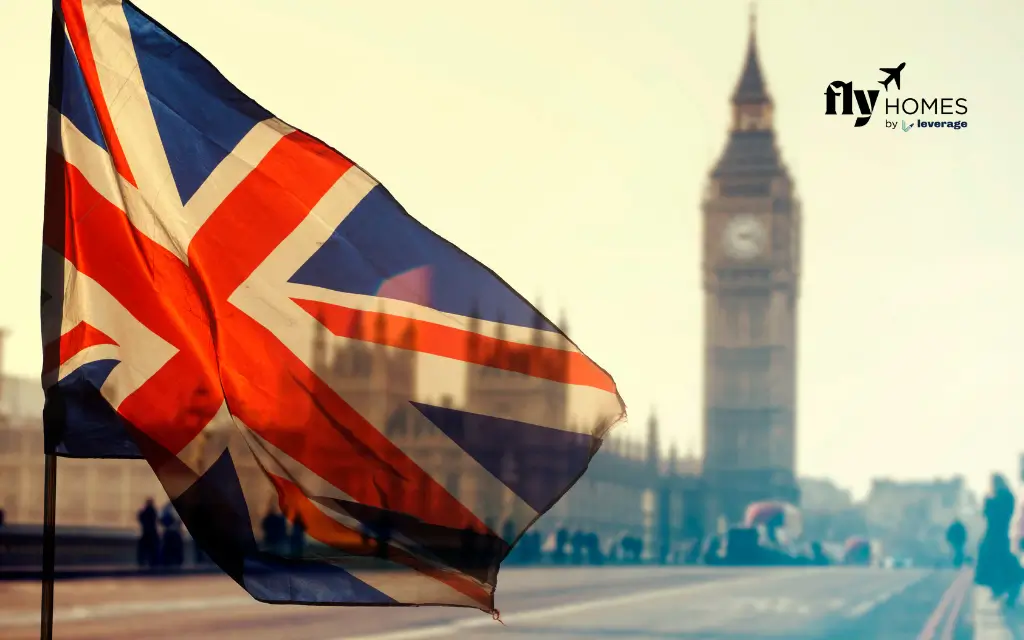Sheldon Cooper presents ‘Fun with Flags.’ Naah! Fly Homes presents ‘Interesting Facts About the European Flags’ or let’s just say we are here to explain the differences between the England Flag and UK Flag. Flags play a crucial role in representing nations, their history, and their identity. However, when it comes to the United Kingdom (UK), Great Britain, and England, many people get confused about which flag represents what. While these terms are often used interchangeably, they refer to different geographical and political entities, each with its own unique history and symbolism.
In this guide, we’ll break down the difference between England Flag and UK Flag, exploring their designs, meanings, and how they came to represent their respective regions. Whether you’re a history enthusiast, a traveler, or just curious about the distinctions, this article will help you understand these iconic flags once and for all.
Table of contents
Differences between England Flag and UK Flag
Many people often confuse the England Flag and the UK Flag, but they are actually different and have unique histories. The England Flag features a red cross on a white background, known as the St. George’s Cross, which represents England. On the other hand, the UK Flag, commonly known as the Union Jack, is a combination of the flags of England, Scotland, and Northern Ireland, symbolizing the unity of the United Kingdom. Understanding these differences helps in recognizing the distinct identities of England and the UK. Here’s a table comparing the differences between the England Flag and the UK Flag:
| Category | England Flag | UK Flag (Union Jack) |
|---|---|---|
| Visual Characteristics | Single red cross on a white background | Complex design featuring red, white, and blue crosses |
| Representation | Symbolizes England as an individual nation | Represents the collective identity of the UK |
| Historical Significance | Ties to military history and the Crusades | Reflects the unification of England, Scotland, and Ireland |
| Origin of Name | – | “Union Jack” derived from its maritime use |
| Legal Display Guidelines | Flown in England, especially on St. George’s Day | Flown across the UK on official holidays |
| Customs of Usage | More common in national events | Prioritized during official ceremonies |
| Symbolic Colors | Red symbolizes strength and valor | Red, white, and blue signify unity and diversity |
| Sports Representation | Used by English teams in international events | Used by UK teams at events like the Olympics |
| Flag Etiquette | Displayed with respect; no upside-down usage | Never flown upside-down except to signal distress |
| Common Misconceptions | Often confused with the UK flag | Misunderstood as representing only England |
| Political Context | – | Associated with historical colonial debates |
Also Read: You may also be interested to know about the best Museums in the UK
Differences between Great Britain Flag and UK Flag
When comparing “Great Britain Flag vs UK Flag,” the confusion arises because Great Britain does not have an official flag. Great Britain does not have a unique flag. It is often represented by the UK flag (Union Jack), but it is not official. So, if someone says “Great Britain Flag,” they likely mean the Union Jack, but there is no separate flag for Great Britain itself.
Let us see a brief comparison of Great Britain Flag vs UK flag in the table given below:
| Feature | Great Britain | United Kingdom (UK) |
|---|---|---|
| Definition | Refers to the island containing England, Scotland, and Wales | Includes England, Scotland, Wales, and Northern Ireland |
| Official Flag | No official flag specifically for “Great Britain” | Union Jack (Flag of the UK) |
| Flag Components | N/A (No specific Great Britain flag) | Combines flags of England (St. George’s Cross), Scotland (St. Andrew’s Cross), and Ireland (St. Patrick’s Cross) |
| Includes Wales? | Yes | Yes |
| Includes Northern Ireland? | No | Yes |
| Historical Background | Term used since the medieval period for the largest island in the British Isles | Formed in 1707 (Kingdom of Great Britain) and 1801 (United Kingdom) |
| Political Status | Part of the UK but does not include Northern Ireland | A sovereign state comprising four nations |
| Used in Sporting Events? | Yes, Great Britain competes as a team in the Olympics | The UK does not compete as a single team in most sports—England, Scotland, Wales, and Northern Ireland have separate teams in FIFA and other tournaments |
| Cultural Identity | Refers to the shared heritage of England, Scotland, and Wales | Represents a broader national identity including Northern Ireland |
United Kingdom, Great Britain & England
Source: World Map
Popularly known as the UK, the United Kingdom is a constitutional monarchy and parliamentary democracy. It describes the political unit of England, Wales, Scotland, and Northern Ireland. Although these countries have their own governments and autonomies, they are not sovereign nations.
Great Britain, on the other hand, constitutes England, Wales and Scotland. Great Britain is a geographical term that does not include the Republic of Ireland or other smaller islands located close to that part of the UK.
England is one of the four countries of the United Kingdom. Just like the other three countries, England is not a sovereign body. However, before the formation of the United Kingdom, England was a sovereign state and was ruled by the same royal family that now ruled the UK.
The UK Flag
The UK flag, also known as the Union Jack, represents the entire United Kingdom. It consists of four crosses: the red cross of England, the white cross of Scotland, the red harp of Ireland, and the white saltire of Wales. These crosses are arranged in a diagonal cross, with the English cross in the upper left and the Welsh cross in the lower right. The UK flag is the national flag of the United Kingdom, representing the unity and diversity of the four countries of the UK.
| Feature | Description |
| Base Colour | White |
| Main Symbol | Diagonal Cross |
| Secondary Symbol | Four Crosses (Red, White, Red, White) |
| Number of Crosses | Four |
| Colour of Crosses | Red, White |
Great Britain Flag
The Great Britain flag originated in 1606 and is also known as the first Union flag. It was used from 1707 as a national flag after the Treaty of Union and Acts of Union. The flag was used as a national flag till 1801. The flag consists of the red cross of Saint George, the patron saint of England, the patron saint of Scotland, and the saltire of Saint Andrew. The blue background in the flag was sky blue but gradually became darker with time.
| Feature | Description |
| Base Colour | Navy Blue |
| Main Symbol | Union Jack |
| Secondary Symbol | Red Saltire of Saint Patrick |
| Number of Crosses | Three |
| Colour of Crosses | Red, White |
England Flag
The England flag, also known as the St. George’s Cross, is the flag of England. It is a simple design consisting of a red cross on a white background. The cross is made up of five smaller crosses, each representing a saint who is traditionally associated with England. The flag has been in use since the Middle Ages and is considered one of the oldest flags in the world. It is primarily used as a regional flag in England.
| Feature | Description |
| Base Colour | White |
| Main Symbol | Red Cross |
| Secondary Symbol | Five Smaller Crosses |
| Number of Crosses | One |
| Colour of Crosses | Red |
Also Read: Let us help you accelerate your accommodation hunt! Check out the best student accommodations in the UK
Interesting Facts about England Flag and the UK Flag
Here are some interesting and important facts about the England Flag and the UK Flag. These flags have a long history and special meanings. The England Flag represents Saint George, while the UK Flag, also called the Union Jack, combines different flags to show the unity of the United Kingdom. Let’s explore some amazing facts about them!
England Flag (St. George’s Cross)
- Oldest National Flag – The England flag, featuring a red cross on a white background, dates back to the 12th century.
- Saint George’s Symbol – It represents Saint George, England’s patron saint, who was a Roman soldier and Christian martyr.
- Inspired the UK Flag – The England flag is a major component of the Union Jack (UK flag).
- Used by the British Royal Navy – The St. George’s Cross was used on ships as early as 1277.
- Official National Flag Since 1606 – Though in use for centuries, it was officially recognized in 1606.
UK Flag (Union Jack)
- Combines Three Flags – The UK flag merges England’s St. George’s Cross, Scotland’s St. Andrew’s Cross, and Ireland’s St. Patrick’s Cross.
- No Wales Representation – Wales isn’t represented in the UK flag because it was already part of England when the Union Jack was designed.
- Not Always Called “Union Jack” – It was originally called the Union Flag, and “Union Jack” is only used when flown at sea.
- First Created in 1606 – The Union Jack was first designed in 1606 and modified in 1801 after Ireland joined the UK.
- Symmetrical Illusion – The Union Jack looks symmetrical, but it isn’t! The diagonal red lines are off-center to distinguish Scotland’s and Ireland’s symbols.
FAQs on England Flag vs UK Flag
The UK flag (Union Jack) represents England, Scotland, Wales, and Northern Ireland, combining their elements. Great Britain has no official flag but is often associated with the Union Jack. England’s flag (St. George’s Cross) is a red cross on a white background and represents England alone.
The England flag, or St. George’s Cross, is named after the patron saint of England, St. George. It symbolizes historical roots and pays homage to a figure revered in English mythology.
The red cross stands for England, the white for Scotland, the red harp for Ireland, and the white saltire for Wales showcasing unity in diversity.
While there’s no legal restriction, it’s advised to consider local sentiments.
While not mandatory, it is customary to fly the UK flag on government buildings.
Yes, Individuals are free to use the UK flag personally.
The Union Jack combines elements from the English, Scottish, and Irish flags, creating a design that represents the union of these nations under one flag.
Wales was already a principality within England when the Union Jack was created, so it wasn’t represented separately in the design.
Yes, both flags can be flown together, especially during events that celebrate both English identity and British unity.
Generally, wearing the flag on clothing is not considered disrespectful, though etiquette may vary, especially for official events or ceremonies.
Officially, the Union Jack’s ratio is 1:2, while the England flag often uses a 3:5 or 1:2 ratio depending on the context.
St. George’s Cross (England’s flag) is the oldest, dating back to the 12th century.
Yes, each country within the UK can use its own flag for sports, regional events, and cultural identity.
Thank you for reading our blog about the difference between England Flag vs UK Flag. We hope you liked this blog. For booking the best accommodation abroad to start your study abroad experience you can contact Fly Homes at 1800572118.
Follow Us on Social Media




























